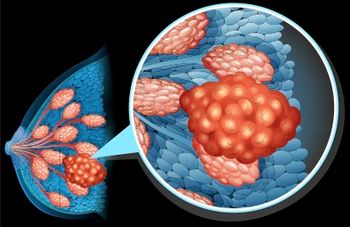
TRBV Gene Use Could Act as Biomarker in HER2+ Breast Cancer
Direct measurements of TRBV genes could provide a biomarker to predict response to dual HER2 blockade in women with HER2-positive breast cancer.
Direct measurements of T-cell receptor β variable region (TRBV) genes could provide a biomarker to predict response to dual HER2 blockade in women with HER2-positive breast cancer, according to a new analysis from the NeoALTTO trial. Increased use of certain TRBV genes could identify those who respond better to dual blockade.
Though the NeoALTTO trial previously showed better outcomes with dual blockade with trastuzumab and lapatinib combined with paclitaxel than with monotherapy, no specific markers have been found that identify those who will benefit from dual blockade but not single-agent HER2 blockade, according to study authors led by Ryan L. Powles, MS, of Yale Cancer Center in New Haven, Connecticut.
The new analysis from the trial examined if the use of TRBV genes could act as such a biomarker. It included 245 patients with HER2-positive breast cancer who were enrolled in the NeoALTTO trial. Gene use was characterized based on TRBV load, TRBV richness, and TRBV entropy. The results were
The analysis identified an “immune cold” cluster of patients with minimal use of most TRBV genes. These patients tended to have a lower rate of pathologic complete response (pCR) than others, at 28% compared with 38% (P = .10). Metrics for TRBV were generally found to be correlated with other measures of immune activity, though not with the rate of somatic mutation.
Further, they found that TRBV11-3 and a metagene known as TMG2 (characterized by use of TRBV4.3, TRBV6.3, and TRBV7.2) were associated with pCR in the full cohort. These two markers also had significant treatment-arm interaction terms, meaning that higher use was associated with a greater probability of pCR in those treated with dual blockade compared with those treated with single-agent HER2 blockade.
When the patients were divided into a TMG2-high and TMG2-low group, those with high levels and with immune-rich tumors (37.6% of the cohort) had a significantly higher pCR rate with dual blockade than with the single-agent arms of the study (68% vs 21%; P < .001). The same was true in immune-poor tumors, where a higher TMG2 level was associated with a 50% pCR rate with dual blockade and only a 6% pCR rate with monotherapy (P = .009).
“Our analysis indicates that use of a very small number of TRBV genes appears to be associated with selective response to dual treatment with trastuzumab and lapatinib, both in immune-rich and immune-poor cancers,” the authors concluded. “If confirmed in additional cohorts, the TRBV signature could help identify patients who do poorly with single anti-HER2 treatments, but benefit from dual blockade.”
Newsletter
Stay up to date on recent advances in the multidisciplinary approach to cancer.


















































































